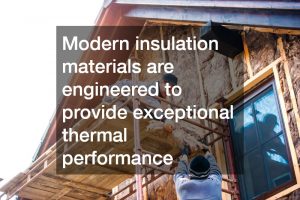
Insulation is at the core of any energy-efficient home or building. Insulation services are crucial in achieving green building goals. Thick insulation is key to maintaining consistent indoor temperatures, reducing energy consumption, and minimizing environmental impact. Preventing heat loss in winter and heat gain in summer significantly lowers heating and cooling costs.
Modern insulation materials are engineered to provide exceptional thermal performance while being environmentally friendly. Heat resistant insulation protects against scorching summer temperatures, ensuring comfort and energy efficiency. Likewise, cold insulation safeguards against frigid winter conditions, creating a cozy and energy-saving interior. It can’t be stressed enough how important insulation is.
Insulation is an essential part of green building for many reasons. Of course, it also provides a great opportunity for cost savings. Well-insulated homes and other structures can be climate-controlled for a fraction of the cost compared to structures of the same size without insulation.
Investing in high-quality insulation is a long-term investment that yields substantial returns in terms of reduced energy bills, increased comfort, and a smaller carbon footprint. It’s a fundamental step towards building a sustainable and eco-friendly living space. Professional insulation services that provide state-of-the-art insulation materials can be your best ally in joining the green building movement.
Green design is no longer something that belongs in the future. It is here and now, and the concern not only of architects, environmentalists, and visionaries, but also of those who bring this vision to life. This includes contractors who build commercial and residential buildings to green codes, electricians, and the construction workers who lay the finishing touches with their cement trowels. Green design has gone from sketch pad to reality and it is transforming the construction industry.
Green design and insulation
Green design is all about reducing the carbon footprint of buildings while making them more environmentally friendly and also healthier for the people and pets who live in them. Lowering energy usage has been a major challenge in designing homes, since heating and cooling costs account for a significant portion of electrical usage in any building. Energy consumption is increased when heated or cooled air escapes through cracks, leaks and drafts in walls, attics, basements, windows, and doors.
In general, heating and cooling costs account for about half of a building’s energy usage. Better insulation can actually reduce energy usage significantly, which is why techniques like spray foam insulation and ICF or insulated concrete forms are being used in new home construction. These also help to make homes healthier by excluding moisture, thereby limiting the growth of mold indoors.
Different methods of insulation
Better insulation makes for more energy efficient buildings. There are several types of insulating materials. Different methods are used in insulating new construction and upgrading or greening existing structures. Spray foam insulation can reduce air conditioning and heating costs by as much as 60%. Insulation also serves to block outside air moisture from entering a building.
This keeps out not only the heat or the cold, but it also blocks moisture from settling into hidden nooks and crannies in the structure. This is important, because moisture forms a home for mold to grow. Mold can be harmful to the health of humans and pets. Insulated green homes are also healthier places to live. Continuous insulation systems like Exterior Insulated Finish Systems (EIFS) can block as much as 55% of outside air from infiltrating a wall, as compared to brick and wood construction.
ICF construction v. wood frames
Insulated concrete forms or ICF are used to build the frame for the house, and concrete trowels are used to finish walls. This is in contrast to the more familiar and conventional wood frame. ICF houses have been built in Europe for a long time and the idea is starting to catch on in the U.S. as well.
ICF structures are better insulated, more durable, and disaster resistant, with the ability to withstand strong winds and heavy rain.
Contractor supplies for ICF and green construction can include foam sealant, concrete trowels, spray foam kits, and of course, work gloves. These simple supplies and tools may be changing the construction industry, one green building at a time.
Green design has moved out from sketch pads to the worksite, where construction crews with their spray foam insulation kits and concrete trowels are building greener, healthier buildings. It is transforming the construction industry, in a good way that will have an impact on how future generations live.

